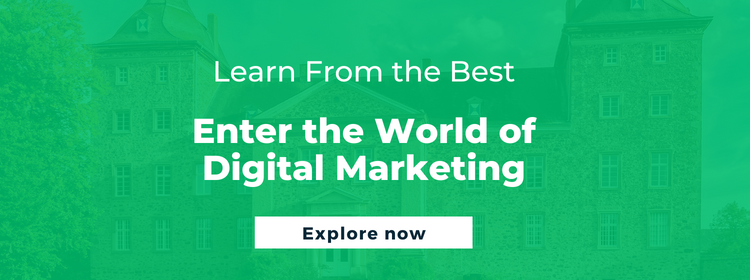45 Basic Digital Marketing Terms: How Many Do You Know?

As of 2022, digital marketing had reached 50% more customers than traditional marketing, as per a Zippia report. This data reinforces the belief that businesses must prioritize digital marketing to stay competitive. However, with the fast-paced and ever-evolving nature of the digital world, keeping track of essential basic digital marketing terms and concepts can be challenging. This knowledge is necessary to provide marketers with a foundation for developing effective strategies that can help reach and engage customers on digital platforms. To help you keep pace, here is a comprehensive glossary of basic digital marketing terms that every marketer should know to stay updated and competitive.
A Complete List of the Basic Digital Marketing Terms That All Marketers Should Know

Here is a glossary of 45 basic digital marketing terms that can help marketers frame the most effective strategies:
1. Search Engine Optimization (SEO)
SEO helps optimize websites by using specific keywords to rank higher in Search Engine Results Pages (SERPs). Furthermore, it involves making changes to the website’s content and structure.
2. Search Engine Marketing (SEM)
SEM involves promoting a website to enhance its visibility on Search Engine Results Pages (SERPs). By using tactics such as Pay-Per-Click (PPC) advertising, keyword research, and optimizing website content, businesses can drive traffic to their website and improve their online presence.
3. Pay-Per-Click (PPC)
This is a popular form of digital advertising businesses use to drive traffic to their website. Advertisers pay a fee every time someone clicks on one of their ads.
4. Content Marketing
By consistently providing valuable content, businesses can establish themselves as thought leaders, build trust with their audience, and drive conversions and sales. As a result, content marketing has become an increasingly popular strategy for businesses of all sizes and across industries.
5. Social Media Marketing (SMM)
Social Media Marketing (SMM) entails promoting products or services on platforms like Facebook, Instagram, and Twitter. It increases brand visibility and website traffic and drives sales growth.
6. Email Marketing
Email marketing sends targeted promotional messages to a specific list of email subscribers. For example, such messages can include newsletters, promotional offers, and relevant content.
7. Brand Positioning
Identifying and communicating a brand’s key attributes and benefits is brand positioning. Marketing managers aim to establish a strong and memorable presence for the brand in the marketplace.
8. Conversion Rate Optimization (CRO)
CRO optimizes a landing page to increase the percentage of visitors who take a desired action, such as making or initiating a purchase. Moreover, CRO is essential for boosting ROI and maximizing the impact of basic digital marketing campaigns.
9. Affiliate Marketing
Affiliate marketing is a basic digital marketing term for a mutually beneficial marketing technique for businesses and affiliates. With affiliate marketing, companies can increase their reach and sales, while affiliates can earn commissions by promoting the products.
10. Call-to-Action (CTA)
Call-to-action, or CTA, is crucial in any digital marketing strategy. It prompts the audience to take a specific action, such as purchasing, subscribing to a newsletter, or downloading an ebook.
11. Key Performance Indicators (KPIs)
Marketers use KPIs as metrics to evaluate the success of a digital marketing campaign. Also, these metrics include website traffic, conversion rates, social media engagement, emails open, and click-through rates.
12. Landing Page
Landing pages are standalone pages that users land on after clicking on a CTA in an advertisement or an email. Furthermore, the primary goal of a landing page is to convert the user into a customer by completing a specific action.
13. A/B Testing
Marketing professionals use A/B testing to compare two versions of a webpage, email, or advertisement to determine the better-performing variant.
14. Click-Through-Rate (CTR)
Marketers rely on CTR to measure the effectiveness of advertisements or web pages. Moreover, marketers can improve CTR and drive more website traffic by optimizing factors such as targeted keywords, creating compelling ad copy, and testing ad designs.
15. Target Audience
Marketing managers aim to reach a target audience through online channels. Consequently, digital marketing companies conduct market research to gather data on customers’ preferences, behaviors, and needs. This data helps to identify the target audience for the company.
16. Return on Investment (ROI)
The measure used to evaluate the profitability of an investment is called ROI. Moreover, it also represents the financial return generated compared to the cost of the marketing campaign in basic digital marketing strategies.
17. Customer Relationship Management (CRM)
CRM is a system or strategy used to manage and analyze customer interactions, data, and relationships throughout the customer lifecycle.
18. Search Engine Results Page (SERP)
SERP is the page search engines display in response to a user’s search query, listing relevant websites and other content.
19. Conversion Rate
The percentage of website visitors who take a desired action, such as purchasing or filling out a form, indicates a conversion rate in basic digital marketing terms.
20. Bounce Rate
The bounce rate is the percentage of visitors navigating away from a website after viewing only one page without engaging further.
21. Influencer Marketing
Collaborating with influential individuals on social media or engaging industry experts to promote products or services to their audiences is called influencer marketing.
22. Account-Based Marketing (ABM)
ABM is a strategic approach that targets and engages specific high-value accounts or companies, tailoring marketing efforts to their unique needs.
23. Chatbot
A chatbot is an AI-powered program that simulates user conversations through a chat interface. They are used for customer support, lead generation, and automated interactions.
24. UX (User Experience)
UX is a user’s overall experience and satisfaction when interacting with a website, application, or digital product. Furthermore, it encompasses factors such as ease of use, accessibility, efficiency, and emotional engagement, ultimately influencing customer loyalty and the overall success of a digital product or service.
25. UI (User Interface)
The visual elements and design components of a website, application, or digital product that users interact with is the User Interface (UI). A well-designed UI enhances user satisfaction, improves usability, and helps users achieve their goals effectively and efficiently.
26. Hashtag
A hashtag is a word or phrase preceded by the “#” symbol used to categorize and identify content on social media platforms. Essentially, it enables marketers to increase the discoverability of their content, reach a wider audience, and join conversations related to their brand or industry.
27. Organic Reach
The organic reach is the number of people who see a social media post or content without paid promotion or advertising. Furthermore, it is essential for building brand awareness, engaging with the target audience, and maximizing the impact of organic content without relying on paid advertising.
28. Impressions
The number of times an advertisement or content is displayed, whether clicked or not, is called an impression in basic digital marketing.
29. Retargeting
Retargeting involves displaying ads to users who have previously visited a website or shown interest in a product or service.
30. CPM (Cost-per-Mille)
A CPM represents the cost of 1,000 ad impressions or views. It is a pricing model commonly used in display advertising.
31. CPL (Cost-per-Lead)
CPL is a metric that determines whether or not your efforts and ad spending are paying off. It is the dollar amount required to generate a new, prospective customer from a current marketing campaign.
32. Meta Tags
Meta tags are HTML tags that provide information about a webpage to search engines. The most common meta tags are the title tag, meta description, and meta keywords tag.
33. Backlink
A backlink refers to a link from another website to your website. It is also an important ranking factor in search engine algorithms and can improve a website’s authority and visibility.
34. Domain Authority
Domain authority is a metric developed by SEO software creator Moz that predicts a website’s ability to rank in search engine results. It is based on backlinks, domain age, and content quality.
35. Content Management System (CMS)
CMS is a software platform that enables users to create, manage, and modify digital content, such as websites, blogs, or online stores, without extensive technical knowledge.
36. Really Simple Syndication (RSS)
In basic digital marketing terminology, RSS is a web feed format that allows users to receive updated content from websites or blogs. Users also subscribe to RSS feeds to stay updated with their favorite websites’ new content.
37. Keyword
A keyword is a specific word or phrase representing the main topic or focus of a webpage or piece of content. Besides, it is essential for search engine optimization and to help drive relevant traffic to a website.
38. Click Fraud
Click fraud is the fraudulent clicking on online advertisements to deplete a competitor’s advertising budget or generate illegitimate revenue. It is also a form of ad fraud that can harm advertisers.
39. Influencer
An influencer is an individual or social media account with a significant following and influence within a particular industry or niche. Additionally, they can also help increase brand awareness as well as promote products or services.
40. Long-Tail Keywords
Long-tail keywords are longer, more specific keyword phrases that are less competitive but have higher conversion potential. They also target niche audiences and can result in more qualified traffic.
41. Digital Analytics
Digital analytics involves collecting, measuring, analyzing, and reporting digital data to understand and optimize marketing efforts. Its tools also track website traffic, user behavior, and campaign performance.
42. Social Listening
Social listening involves monitoring and analyzing conversations and mentions on social media platforms to gain insights into customer sentiment, industry trends, or brand reputation.
43. Churn Rate
The churn rate is when customers or subscribers stop using or cancel a product or service. Likewise, a high churn rate indicates a need to improve customer retention efforts.
44. Lead Generation
Lead generation refers to attracting and converting potential customers into leads by offering valuable content or incentives in exchange for contact information.
45. Conversion Funnel
Conversion funnel refers to a series of stages a user goes through, from initial awareness to final conversion. Furthermore, the stages typically include awareness, interest, consideration, and action.
ALSO READ: How to Build a Successful Career in Digital Marketing
Frequently Asked Questions
1. How Important is it to Understand Digital Marketing Terminology?

Understanding basic digital marketing terminology helps marketers effectively communicate and implement digital marketing strategies, making informed decisions. Additionally, they can accurately measure the success of their campaigns. It also lets marketers stay up-to-date with the industry’s latest trends and best practices.
2. How Has Digital Marketing Language Evolved Over the Years?
The digital marketing language has evolved as new technologies have emerged. This has led to the rise of new terms.
3. How Can You Keep Up With the Constantly Changing Terminology?
You can stay up-to-date with digital marketing terminology by studying trends and upgrading your knowledge of this fast-paced industry. Resources such as publications, reports, and online courses can help.
4. Can Misinterpreting Digital Marketing Language Affect a Company’s Marketing Efforts?
Clear communication and understanding of digital marketing terms and concepts are critical for developing effective marketing strategies and campaigns. A misinterpreted or misunderstood language can lead to mistakes in strategy, incorrect targeting, and wasted resources.
Learn More About Digital Marketing With Emeritus
Digital marketing is a constantly evolving field that requires a deep understanding of various strategies and tactics to be successful. Moreover, as more businesses focus on digital channels, a solid grasp of basic digital marketing has become necessary for professionals across industries.
Emeritus provides digital marketing courses that endow learners with the practical skills and knowledge necessary for success in today’s fast-paced digital landscape. Also, the courses are comprehensive and cover a broad range of topics. These will help you upgrade your knowledge in basic digital marketing terms.
Write to us at contact@emeritus.org
























